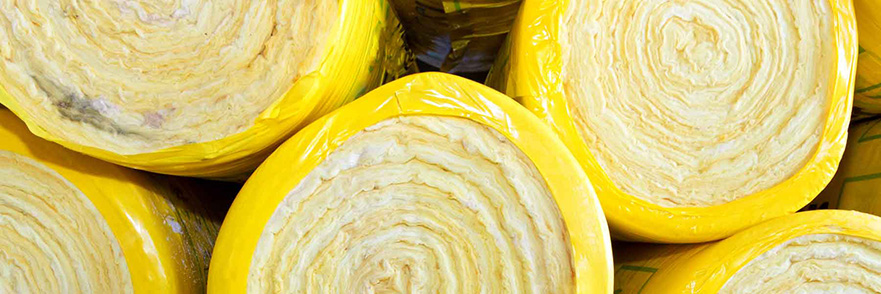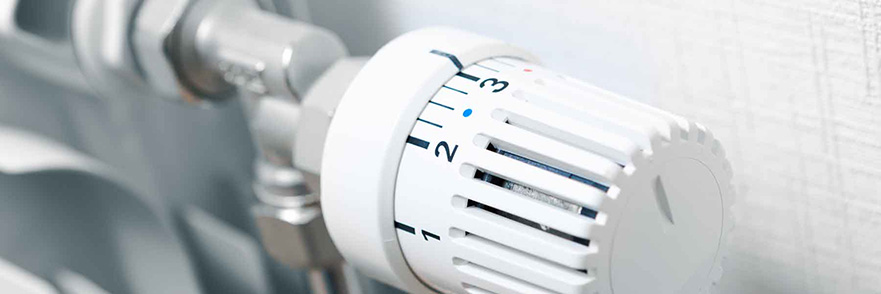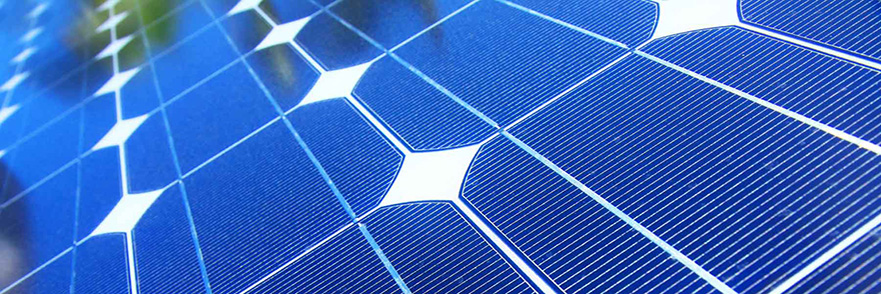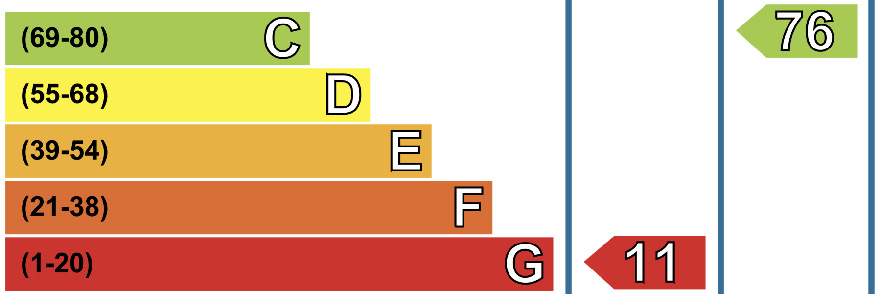What Factors Affect EPC Rating?
To calculate your energy consumption and emissions, your home is assessed upon:
For an EPC, your home is only assessed on these measures above and not based on energy usage for any other daily living purposes such as cooking, watching TV or using appliances and electrical goods.
All the appliances used for heating, lighting and hot water will be considered and your energy consumption calculated on the:
- The amount of energy used per m2
- The level of CO2 emissions (given in tonnes per year)
An EPC calculation is complex, but is affected by the following factors:
- Insulation of walls
- Insulation of roof
- Insulation of floor
- Thermal transmission of windows
- Heating
- Heating controls
- Secondary heating
- Hot water
- Lighting
- Airtightness
The types of energy used are also considered such as:
- Electricity
- Gas
- Renewable energy sources (solar panels, wind turbines)
Note, currently, the EPC favours gas over electricity as an energy source. However, with gas boilers set to be phased out of usage in the near future, this is likely to change soon and renewable energy is most likely to be favoured.
The Main Ways to Improve Your EPC Rating
Lighting
Lighting has been impacted significantly since 2009 by the EU Directive with bans on certain types of bulbs, which 64% of householders are unaware of1. The aim is to reduce the 19% global consumption of energy by lighting2.
Not so long ago, all houses were lit with the traditional incandescent bulb but they began to be phased out in 2009 and are now banned from sale in the UK.
Halogen downlights embedded in ceilings became hugely popular, with an estimation that the average UK household has 10 halogen bulbs. Not as efficient as LED, halogens only have a working life of two years (at three hours per day use) by delivering bright spotlights.
Since 2018, halogen bulbs have now been removed from sale across Europe with a drive to push households to more energy-efficient choices.
Bulb choices for sale are now limited to LEDs and compact fluorescent lamps (CFLs) and all households will have to upgrade their lighting as old bulbs expire.
The benefit of swapping ten halogen bulbs for LEDs will equal a saving of £112 a year over a long-term period, according to Philips lighting manufacturer3. Halogens only have a working life of two years, whilst an LED can last 20-30 years delivering considerable savings over the long term.
An old incandescent style 100W bulb costs £20 a year to run, in comparison to an LED bulb at only £5 a year.
LEDs are sold in lumens as compared to wattage: a traditional 100W bulb is equivalent to a 13.5WLED and a traditional 75W bulb is equivalent to an 8.5W LED.

Insulation
Loft Insulation
Easy to install, unintrusive, relatively inexpensive and can help to retain a quarter of household heat that is lost through the roof4. For the significant difference it can make to your EPC score, it’s one of the easiest ways to add several points.
- A 270mm minimum depth of rock wool insulation is recommended.
Cavity Wall Insulation
The process of filling the cavities inside your external walls by injecting polystyrene beads or by installing mineral wool and is relatively inexpensive and easy to complete. As a third of heat is lost through uninsulated walls5, this process will make a difference to the energy efficiency of your home.
Most houses built after 1990 are already insulated but a house built between 1920 and 1990 will most likely have cavity walls that may need insulating.
There is a caveat that not all buildings are suitable for cavity wall insulation, as it can result in problems with dampness and mould and this can affect people's health. The most unsuitable buildings are those exposed to excessive wind and rain (mainly in the West) and we recommend seeking advice to find out if your property is suitable. There is a useful map here.
It's vital to find a reputable supplier, as poorly fitted cavity wall insulation can be incredibly costly to fix.
Note, that you will have to provide evidence of the insulation during an assessment. An assessor will need to either visibly see the insulation or be provided with documentation that the insulation has been installed.
A G-rated semi-detached house can make savings of:
- Roof insulation £252 per year
- Cavity wall insulation £726 per year
Solid Wall Insulation
Used to improve the thermal property of a solid wall. Houses built before 1920 usually have a solid wall. It involves cladding the external walls and covering in render, and/or cladding internal walls with insulating material. This does require moving radiators and sockets, so it's both intrusive and a large investment.
Hot-water Cylinder Insulation
If you have an old hot water cylinder, then lagging with a cylinder jacket will retain the heat for longer and could save £20 a year. The connecting hot pipes can also be protected with foam tubes and these can be bought from any DIY store.

Double Glazing
Windows are responsible for up to 40% of heat loss in the home6. Therefore, by replacing old windows with high-performance glazing, you can make considerable savings on energy consumption by reducing heat loss.
To understand what the independent ratings for different windows and glazing mean, this page explains what to look for in an energy-efficient window.
Not only do windows have thermal properties, but they also benefit from noise reduction (but this isn't relevant to your EPC rating).
If you live in a listed building, you may not be able to replace windows with double glazing but you can add secondary glazing – not as efficient but it does make a small difference.
- If choosing new windows, look for a minimum of A-rated windows with Low-E glass.

Heating
As heating equates to 55% of your energy bills7, this is the area where changes can have a significant impact.
The EPC rating is measured on the unit cost of energy (and the CO2 emissions to produce the fuel) supplied to the heating system and not necessarily what are a more efficient means of heating in individual circumstances. For example, a large open space is cheaper to heat with a point-of-source heater, such as a portable electric convector, rather than trying to heat the entire space with gas central heating.
In terms of gas versus electric, a gas central heating system will always score higher because it's a cheaper unit of energy and has fewer emissions. An up-to-date gas combi-boiler will provide the highest EPC rating and if you can install a gas central heating system, then this is the best option.
Gas boilers are about to be phased out and banned from installation in new homes in 2025, expect changes to be made to how the EPC ratings are calculated.
Electric heating systems lose out because they are more expensive per kW to heat a property, even though in many cases they are more efficient at the point of source and ultimately offer a cheaper bill.
Modern convector heaters, which may be more practical, are considered the least efficient because they use the highest rate of electricity and cost the most per unit of energy to run (three times as expensive as gas and more expensive than Economy 7).
Storage heaters are rated higher than convectors purely because they benefit from night-time cheaper tariffs even though they aren’t always the most efficient solution and aren’t always practical for delivering heat when it’s needed. Usually, a property needs to rely on an alternative form of heating in the evenings once the storage heater runs cold. But, for EPC purposes, a modern smart storage heater will get a better rating if you have to rely on electricity based heating.
A G-rated, semi-detached house can make savings of:
- Installing high heat retention storage heaters - £657 per year
Main Heating Controls
For those that have gas central heating, the use of thermostatic radiator valves on each individual radiator is a cheap investment and a quick win to improve your EPC rating.
Using a room thermostat will also better manage your energy usage and will have a positive influence on your rating.
Boiler Replacement
Replacing an old boiler can have a significant impact on the energy efficiency of your heating and your EPC rating.
Replacing an old, G-rated (appliance rating) boiler that has less than 70% efficiency, with a new, A-rated condensing boiler with a programmer, room thermostat and thermostatic radiator controls, can make an annual saving of £305 for a detached house.

Renewable Energy
The installation cost for renewable energy sources such as solar panels, ground-source heat pumps or biomass boilers can be prohibitive but the investment will deliver much lower energy bills, reduce carbon dioxide emissions and will also benefit from an increased EPC rating.
In an ideal world, all energy would be supplied from wind farms and solar panels and the UK has a target of renewable energy sources delivering 15% of all energy by 2020.
For an individual property, installing solar panels to harvest sunlight can heat hot water systems. Ground-source heat pumps, that extract natural warmth from the Earth, can efficiently heat a home.
With the changes to gas boilers being introduced, expect a push towards ground source heat pumps and solar water heating.
To achieve the highest EPC ratings a property would require some form of renewable energy.
A G-rated, semi-detached house can make savings of:
- Installing solar water heating - £135 per year
- Installing solar panels - £311 per year
- Installing a wind turbine - £594 per year

How to improve an EPC rating from E to C
Improving an EPC rating of E to C will require investments in heating and insulation. The easiest things to change are to ensure you have low energy lighting throughout the property and to use thermostat controls on radiators.
Use an insulation jacket on a hot water tank and lag pipes supplying the tank and have timer controls on hot water heating.
Upgrade windows to A-rated double glazing or add secondary glazing.
You will also need to address the heating supply and consider high heat retention storage heaters if electricity is your only energy source.
Getting from an E to a C rating will probably require cavity wall insulation if you don't have it. Top up the insulation in your loft to a minimum depth of 270mm.
All properties are different so consult a qualified EPC surveyor before making significant investments.
How to improve an EPC rating from C to B or A
If you already have a high rating such as C or B to achieve a top rating you would need to install renewable energy sources such as solar panels, ground source heat pumps, or wind turbines.
The information and values above are taken from actual EPC certificates. This page is a guide only and not a source of legal information.
Sources:
1. which.co.uk/reviews/light-bulbs/article/how-to-buy-the-best-light-bulb-a5ZLF4v6VDlw
2. theguardian.com/environment/2012/aug/31/lightbulbs-incandescent-europe
3. theguardian.com/money/2018/aug/11/switch-led-light-bulbs-halogen-ban
4. energysavingtrust.org.uk/advice/roof-and-loft-insulation/
5. energysavingtrust.org.uk/advice/cavity-wall-insulation/
6. haringey.gov.uk/environment-and-waste/going-green/green-home-improvements/heat-loss-homes
7. energysavingtrust.org.uk/advice/boilers/